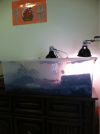- Joined
- Feb 12, 2012
- Messages
- 892
Ok I know I've seen alot of threads on humidity lately but some of them get run together and I'm seeing different things as responses. So my question is this. My enclosure is covered comepletely with two holes one for the CHE and one for the light. My substrate is VERY moist but my ambient humidity only stays around 60% at most unless I spray it then it rises to 80-90% for a few minutes then falls back down again. I have no way of checking the humidity inside the hide either. Is my humidity fine or do I need and an under the tank heater? Also the substrate isn't very warm. And I don't want her to get shell rot I've seen so many conflicting things on this subject.

